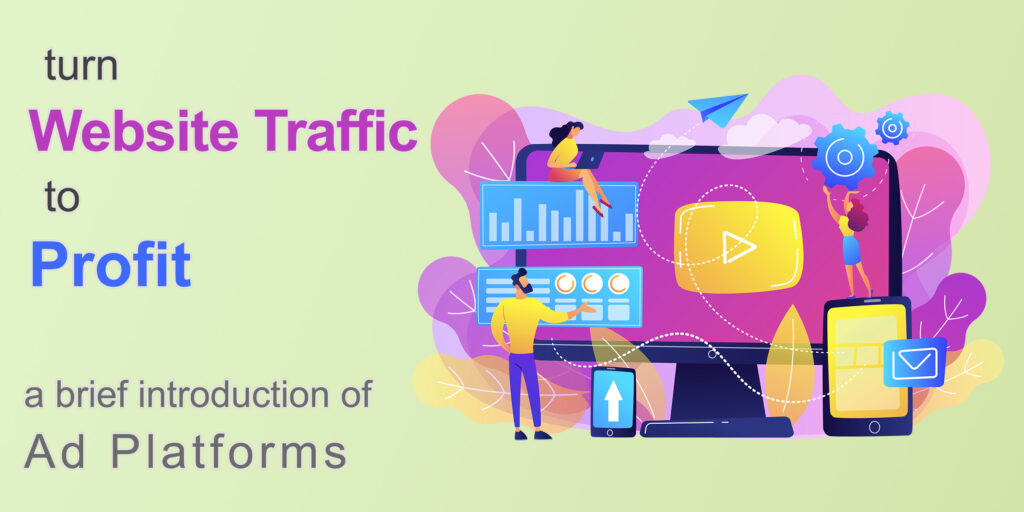In the current era of digital technology, websites have become more than just online spaces for sharing information or expressing ideas. They can also be lucrative sources of income, thanks to various advertising platforms like Google AdSense, Microsoft PubCenter, and other third-party media platforms. These platforms enable website owners to monetize their traffic by displaying ads and earning revenue from clicks or impressions. In this comprehensive guide, we’ll explore how to effectively transfer your website traffic into profit using these ad platforms.
1. Understanding the Basics of Ad Platforms
Before diving into the strategies for maximizing revenue, let’s first understand the fundamental concepts of ad platforms.
Google AdSense: Google AdSense is one of the most popular advertising platforms, allowing website owners to display Google ads on their web pages. It operates on a pay-per-click (PPC) model, meaning you earn money when visitors click on the ads or view them (impressions). Google’s vast advertiser network ensures a wide variety of ad types and sizes.
Microsoft PubCenter: Microsoft PubCenter, also known as Microsoft Advertising, offers a similar service to Google AdSense. It allows you to display ads on your website and earn revenue from clicks and impressions. While not as large as Google’s network, Microsoft Advertising provides a valuable alternative.
Third-Party Media Platforms: Apart from Google and Microsoft, numerous third-party ad networks and media platforms are available. These platforms offer diverse ad formats, targeting options, and revenue-sharing models. Some notable examples include Amazon Associates, Media.net, and Taboola.
2. Preparing Your Website for Ad Integration
Before you can start profiting from ads, you need to ensure your website is ready for ad integration. This involves several crucial steps:
Quality Content: High-quality content is the cornerstone of any successful website. Ensure your website offers valuable, engaging, and relevant content to attract and retain visitors.
Mobile Optimization: Given the increasing use of mobile devices, make sure your website is mobile-friendly. Ad platforms prioritize mobile-optimized sites, and this can impact your ad revenue.
Page Speed: Slow-loading pages can deter visitors and lower your ad revenue. Optimize your website’s speed by compressing images, using content delivery networks (CDNs), and reducing unnecessary scripts.
Compliance with Policies: Familiarize yourself with the policies and guidelines of your chosen ad platforms. Ensure your website content aligns with their terms of service to prevent suspension or termination.
3. Selecting the Right Ad Platforms
Choosing the right ad platforms is essential for maximizing your revenue potential. Here’s how to make an informed decision:
Audience Demographics: Consider your website’s target audience and demographics. Some ad platforms may perform better with specific demographics, so choose the one that aligns with your audience.
Ad Formats: Evaluate the ad formats offered by each platform. Some platforms specialize in display ads, while others focus on video or native advertising. Select the platform that best matches your content and audience.
Revenue Models: Compare the revenue-sharing models of different platforms. While most use a PPC or CPM (cost per mille) model, the revenue split can vary. Research and choose the one that offers competitive rates.
Payment Thresholds: Review the minimum payout thresholds of each platform. Ensure it’s attainable based on your website’s traffic and expected earnings.
4. Optimizing Ad Placement
Now that you’ve chosen your ad platforms, it’s time to optimize the placement of ads on your website. Effective ad placement can significantly impact your revenue.
Above the Fold: Place ads in visible areas above the fold (the part of the webpage visible without scrolling). These positions tend to receive higher user engagement and click-through rates (CTRs).
Blend with Content: Make your ads visually appealing by blending them with your content. Use matching color schemes and fonts to ensure they look like a natural part of your website.
Responsive Design: Utilize responsive ad units that adapt to various screen sizes and devices. This ensures a seamless user experience and maximizes ad visibility.
Avoid Ad Clutter: While it’s tempting to display multiple ads, avoid cluttering your pages with too many. Overloading your website with ads can annoy visitors and decrease overall user satisfaction.
5. Implementing Effective Ad Targeting
To increase the chances of attracting relevant ads and boosting revenue, implement effective ad targeting strategies:
Keyword Research: Research keywords relevant to your content and integrate them strategically. Ad platforms often use keywords to determine which ads to display.
User Behavior Analysis: Use analytics tools to understand user behavior on your website. This data can help you tailor ad placements to user preferences.
Demographic Targeting: Leverage demographic targeting options provided by ad platforms to reach specific audience segments. This can lead to more relevant ads and higher engagement.
A/B Testing: Continuously experiment with ad placements, sizes, and types to identify what works best for your audience. A/B testing can help you optimize ad performance over time.
6. Monitor and Analyze Performance
Monitoring and analyzing ad performance is crucial for ongoing success. Here’s how to do it effectively:
Analytics Tools: Implement robust analytics tools like Google Analytics to track user behavior, traffic sources, and conversion rates. This data can help you fine-tune your ad strategy.
Ad Platform Insights: Use the reporting and analytics tools provided by your chosen ad platforms to gain insights into ad performance, CTRs, and earnings.
Performance Metrics: Focus on key performance metrics like CTR, RPM (revenue per mille), and eCPM (effective cost per mille) to assess the effectiveness of your ad strategy.
Regular Evaluation: Continuously evaluate the performance of your ad placements and targeting. Make adjustments based on what’s working and what’s not.

7. Diversify Revenue Streams
While ad platforms are a reliable source of revenue, consider diversifying your income streams for long-term financial stability:
Affiliate Marketing: Partner with relevant affiliate programs to promote products or services related to your content. Earn commissions on sales generated through your affiliate links.
Sell Digital Products: Create and sell digital products like e-books, courses, or premium content to your audience.
Membership Models: Offer membership or subscription plans for exclusive access to premium content, ad-free experiences, or other benefits.
Sponsored Content: Collaborate with brands for sponsored content opportunities that align with your website’s niche.
Conclusion
Turning your website traffic into profit with ad platforms like Google AdSense, Microsoft PubCenter, and third-party media platforms requires careful planning, optimization, and ongoing analysis. By focusing on quality content, selecting the right ad platforms, optimizing ad placement, implementing effective targeting, and diversifying income streams, you can maximize your website’s revenue potential. Remember that success in the world of online advertising takes time, patience, and a commitment to providing value to your audience while monetizing your digital assets responsibly.
For more information, visit Bel Oak Marketing.





